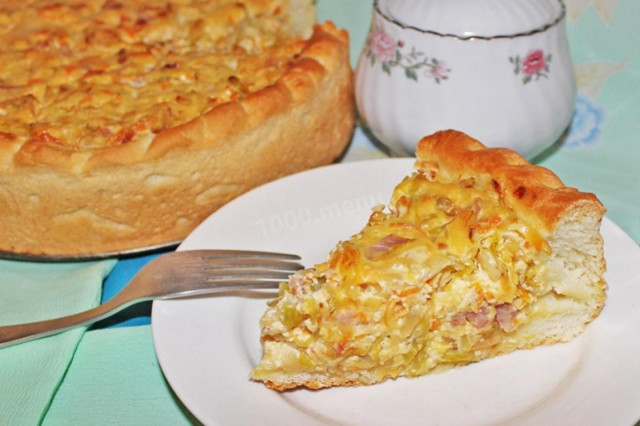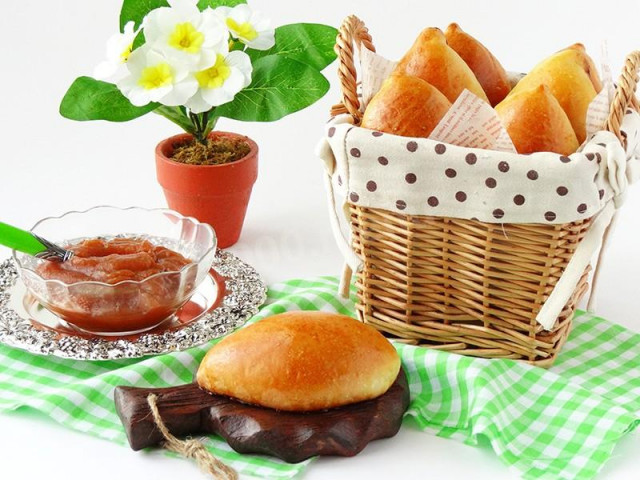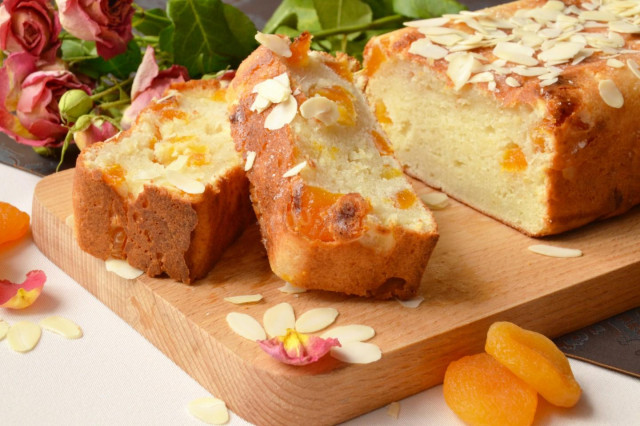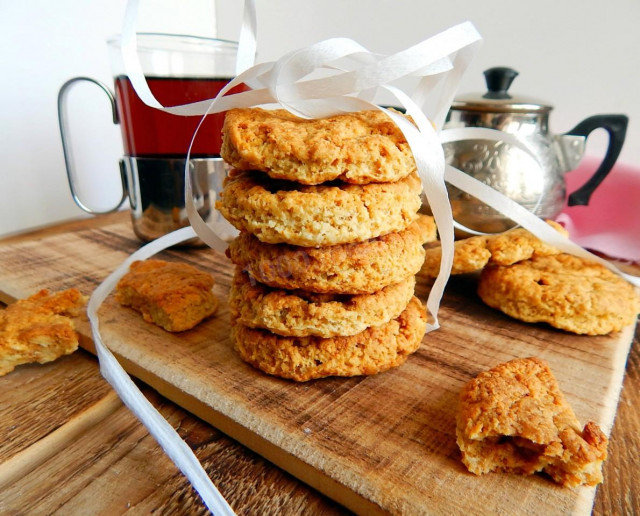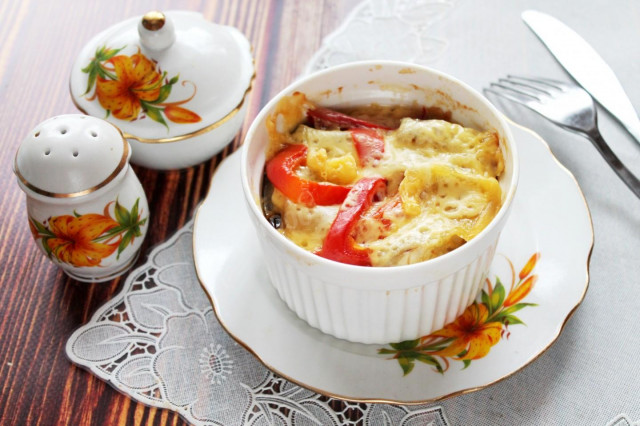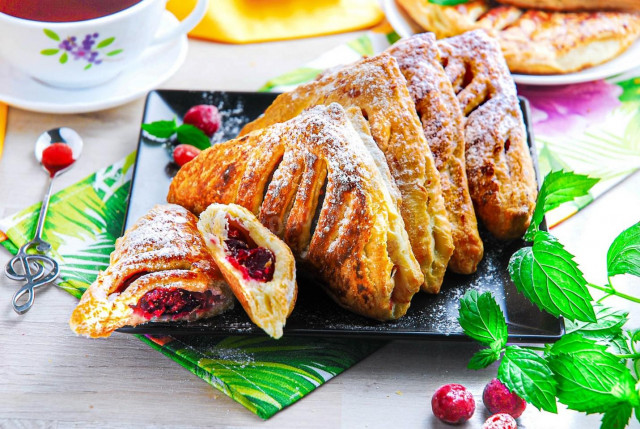Composition / ingredients
Step-by-step cooking
Step 1:

How to bake a cabbage pie? Prepare the ingredients for the dough. Pay special attention to the quality of yeast. Take the flour of the highest grade. Sift it through a fine sieve in advance to saturate it with oxygen. Remove the butter from the refrigerator in advance and bring it to room temperature.
Step 2:
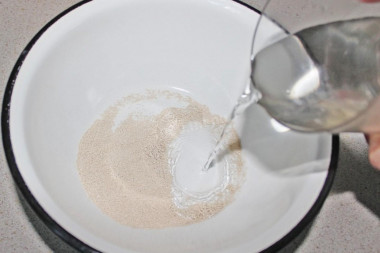
To start, dilute the yeast in warm water in a separate bowl. Let the sourdough rise for 15 minutes. You can cook in a safe way by selecting active yeast, which is added directly to the flour in the form of powder.
Step 3:
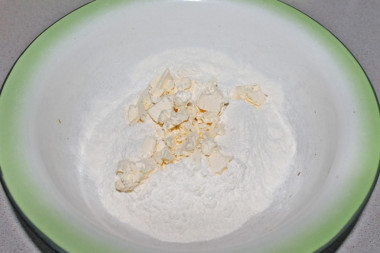
Put the softened butter in a bowl and mix with the sifted flour and salt.
Step 4:
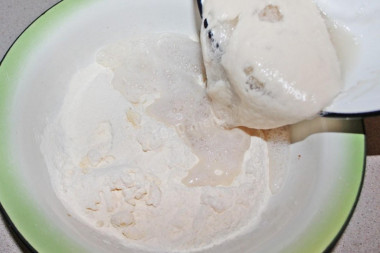
Add the yeast mixture to the flour and start kneading the dough in any way convenient for you: with a spoon, fork, mixer, hands. Focus on the density of the dough, not the amount of flour. It should be moderately cool, keeping its shape well.
Step 5:
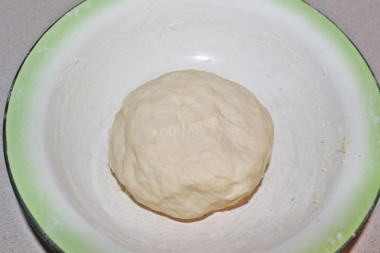
Roll the dough into a ball, cover with a towel and let it lie for about half an hour.
Step 6:
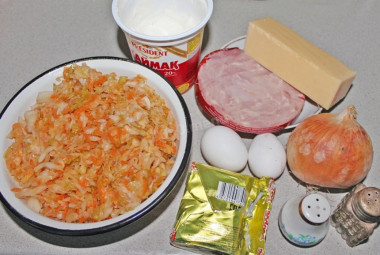
Meanwhile, do the stuffing. Prepare the ingredients for her.
Step 7:

Squeeze the juice out of the sauerkraut. And cut the bacon into small pieces. You can use straws.
Step 8:

Peel the onion from the husk and chop finely. Cut the leek into pieces about 1 cm in length.
Step 9:
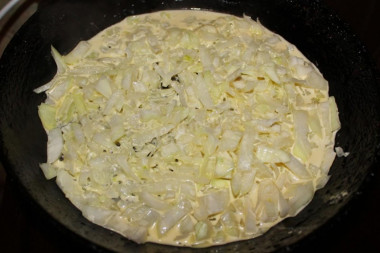
Heat a frying pan with butter and fry all the chopped onions for about 2 minutes.
Step 10:

Add the squeezed sauerkraut to the onion. Pour in a small amount of water and simmer the resulting mass for about a quarter of an hour, stirring from time to time. Make the fire slightly below average. If it starts to burn, reduce it to weak.
Step 11:
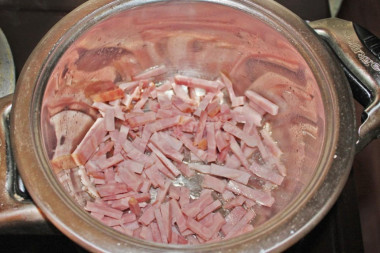
Fry the bacon separately in a frying pan.
Step 12:

Beat raw chicken eggs into a bowl and mix with sour cream until smooth.
Step 13:

Grate the hard cheese.
Step 14:
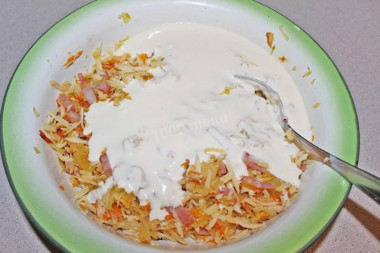
Combine the cooled stewed sauerkraut with grated cheese, a mixture of eggs and sour cream, as well as fried bacon. Mix it up.
Step 15:

In a prepared and oiled form, transfer the dough rolled into a round layer, leaving the sides of it about five centimeters high. Cover the mold with a towel and leave the dough to rise for another quarter of an hour.
Step 16:

Then prick the dough in different places with a fork. Spread the finished filling evenly over the dough and fill to the top. You can make the sides more beautiful and curly.
Step 17:
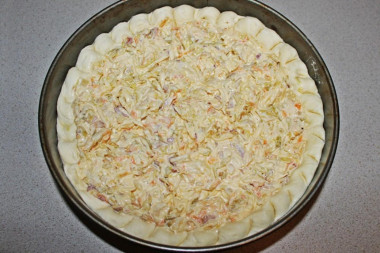
Bake the pie in a preheated 200 degree oven for at least 40 minutes. By time, focus on your oven. It may take you less or more time than I do. Check out the pie!
Step 18:
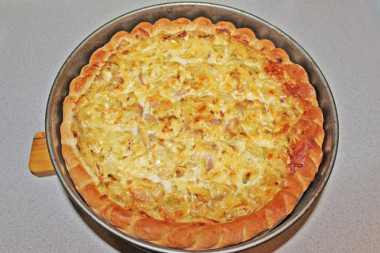
The finished sauerkraut pie must be left to cool before use.
Step 19:
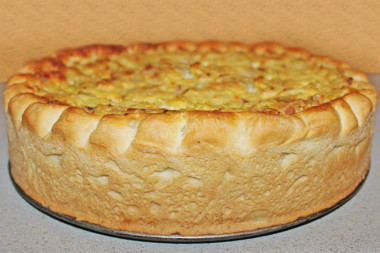
Delicious sauerkraut pie is ready! The dough turns out soft and airy.
Step 20:
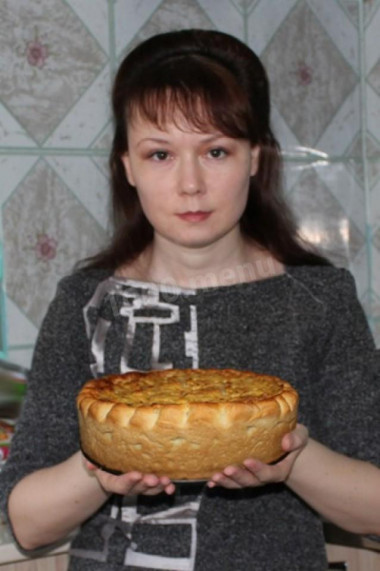
Bon appetit to everyone!
A very delicious version of making a pie with sauerkraut – I highly recommend it for cooking!
At its core, a sauerkraut pie reminds me of a pizza cooked exclusively in the Russian way. There is absolutely nothing complicated in the cooking recipe, but you will have to tinker a little.
Keep in mind that everyone's ovens are different. The temperature and cooking time may differ from those specified in the recipe. To make any baked dish successful, use useful information about the features of ovens !
The liquid in which yeast is bred should be pleasant to the touch, no higher than 40 degrees. Why is this important? In a warm environment, yeast is well activated, in a hot one it will die, and in a cold one it simply will not work. To avoid unpleasant surprises, check the yeast before mixing with the rest of the ingredients. Pour a little warm milk into a bowl, stir in the yeast. Cover the bowl with a kitchen towel and put it in a warm place without drafts for 10-15 minutes. During this time, a foam yeast cap should appear on the surface of the sponge. If this did not happen, then the fermentation process has not started (the yeast is overdue or spoiled). In this case, it is worth taking other yeast, otherwise baking will not work.
Caloric content of the products possible in the composition of the dish
- Sour cream with 30 % fat content - 340 kcal/100g
- Sour cream of 25% fat content - 284 kcal/100g
- Sour cream with 20 % fat content - 210 kcal/100g
- Sour cream of 10 % fat content - 115 kcal/100g
- Sour cream - 210 kcal/100g
- Chicken egg - 157 kcal/100g
- Egg white - 45 kcal/100g
- Egg powder - 542 kcal/100g
- Egg yolk - 352 kcal/100g
- Ostrich egg - 118 kcal/100g
- Dutch cheese - 352 kcal/100g
- Swiss cheese - 335 kcal/100g
- Russian cheese - 366 kcal/100g
- Kostroma cheese - 345 kcal/100g
- Yaroslavsky cheese - 361 kcal/100g
- Altai cheese 50% fat content - 356 kcal/100g
- Soviet cheese - 400 kcal/100g
- Cheese "steppe" - 362 kcal/100g
- Uglich cheese - 347 kcal/100g
- Poshekhonsky cheese - 350 kcal/100g
- Lambert cheese - 377 kcal/100g
- Appnzeller cheese with 50% fat content - 400 kcal/100g
- Chester cheese with 50% fat content - 363 kcal/100g
- Edamer cheese with 40% fat content - 340 kcal/100g
- Cheese with mushrooms of 50 % fat content - 395 kcal/100g
- Emmental cheese with 45% fat content - 420 kcal/100g
- Gouda cheese with 45% fat content - 356 kcal/100g
- Aiadeus cheese - 364 kcal/100g
- Dom blanc cheese (semi-hard) - 360 kcal/100g
- Lo spalmino cheese - 61 kcal/100g
- Cheese "etorki" (sheep, hard) - 401 kcal/100g
- White cheese - 100 kcal/100g
- Fat yellow cheese - 260 kcal/100g
- Altai cheese - 355 kcal/100g
- Kaunas cheese - 355 kcal/100g
- Latvian cheese - 316 kcal/100g
- Limburger cheese - 327 kcal/100g
- Lithuanian cheese - 250 kcal/100g
- Lake cheese - 350 kcal/100g
- Gruyere cheese - 396 kcal/100g
- Ground black pepper - 255 kcal/100g
- Pressed yeast - 109 kcal/100g
- Whole durum wheat flour fortified - 333 kcal/100g
- Whole durum wheat flour, universal - 364 kcal/100g
- Flour krupchatka - 348 kcal/100g
- Flour - 325 kcal/100g
- Cumin - 333 kcal/100g
- Butter 82% - 734 kcal/100g
- Amateur unsalted butter - 709 kcal/100g
- Unsalted peasant butter - 661 kcal/100g
- Peasant salted butter - 652 kcal/100g
- Melted butter - 869 kcal/100g
- Leek - 33 kcal/100g
- Boiled bacon - 447 kcal/100g
- Sauerkraut - 19 kcal/100g
- Salt - 0 kcal/100g
- Water - 0 kcal/100g
- Onion - 41 kcal/100g

